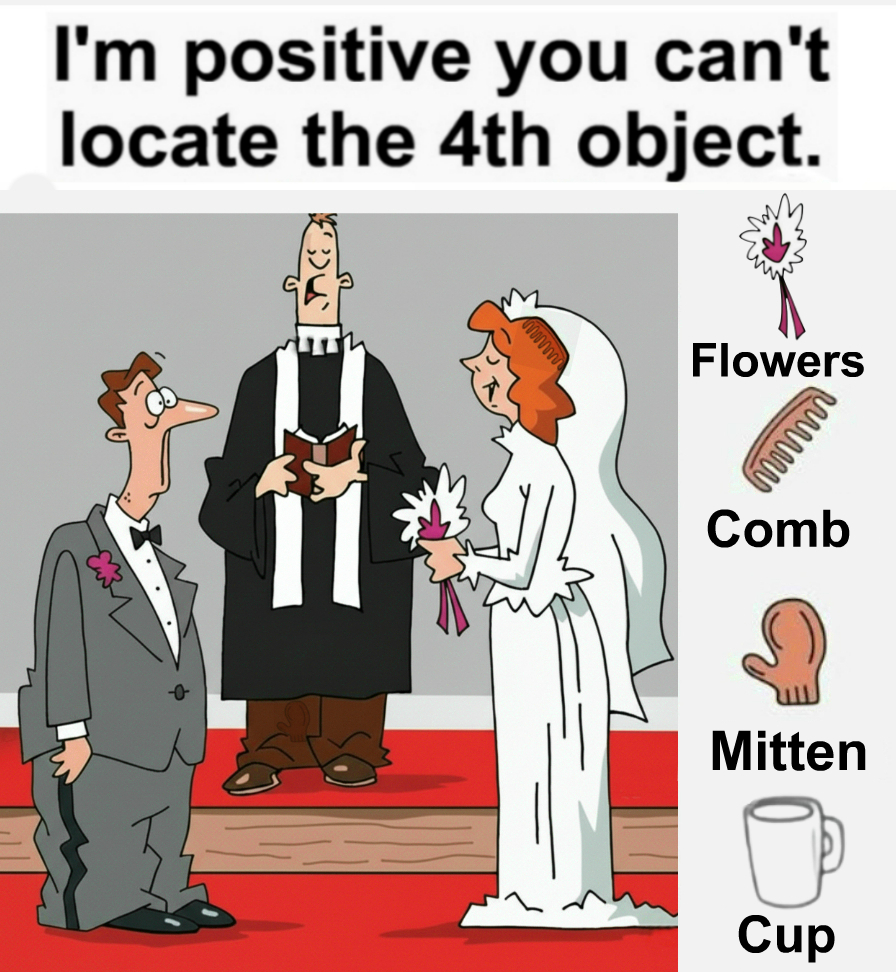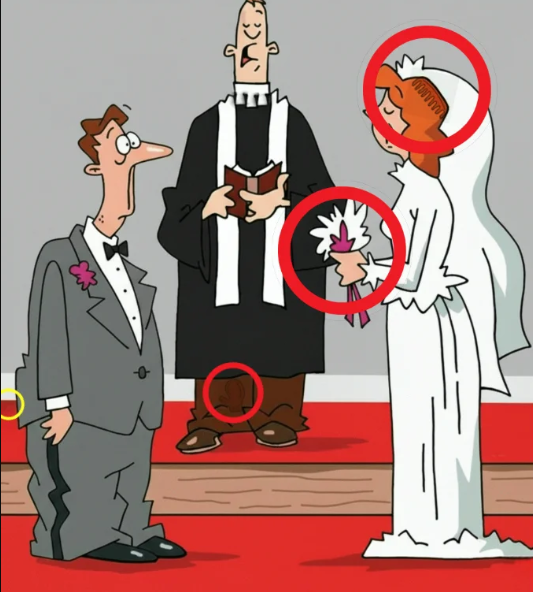Wedding scenes are usually all about romance, emotions, and happy tears—but in this clever picture riddle, they are also about sharp eyes and logical thinking. In the illustration, we see a groom, a bride, and a minister standing at the altar. It looks like a perfectly normal wedding ceremony… until you realize there are four objects hidden in the scene: flowers, a comb, a mitten, and a cup.
Can you find all four without any help?
Where would you hide a mitten in a wedding picture?
And which object do you think will be the hardest to spot?
Before you read the explanation, take a moment to really look at the image. Scan it from top to bottom, from the bride’s veil to the groom’s shoes. Make your own guesses first. The more you interact with the puzzle, the more satisfying it will feel when you discover the answers.
Why We Often Miss the Hidden Objects
Even though the puzzle looks simple, many people struggle to find all four items. That’s not because they are bad at puzzles—it’s because the human brain has habits that puzzle creators love to exploit.

We see “stories,” not shapes
When you first look at the picture, your mind doesn’t think “bride, groom, vertical lines.” Instead, it thinks, “A couple is getting married, the priest is talking, this is a wedding.” You focus on the story of the scene, not on every tiny detail. This makes it very easy for hidden objects to blend into the background.
We expect objects to appear where they belong
A comb belongs in a bathroom or on a dressing table, not floating above a veil. A cup should be on a table, not attached to someone’s clothing. When objects show up in unexpected locations, your brain quietly ignores them because they do not match your expectations.
We rush instead of observing
Most people give the picture just a few seconds. They quickly sweep their eyes across it and assume that if nothing jumps out, nothing is there. But this type of puzzle rewards patience, not speed. The objects are disguised using color, shape, and position. Only a slow and careful search will reveal them.
We overlook small, “unimportant” areas
Corners, folds of fabric, edges of clothing, and background details look unimportant at first glance. That is exactly why they are perfect hiding spots. If you only examine faces and central objects, you will almost certainly miss at least one item.
Understanding these common mistakes helps you approach the puzzle more strategically. Now, let’s walk through the solution step by step.
Video : I bet $15,000 you Cant find the 4th Object! Hard
Step-by-Step Guide to Finding All Four Objects
1. The Flowers
This might sound easy—the bride is clearly holding a bouquet, right? And you’re correct: the flowers you are asked to find are indeed the bouquet in the bride’s hands.
So why is this even a challenge? Because many players overthink it. They assume the answer has to be “hidden” in some impossible place, so they ignore the most obvious option. Sometimes the trick in a puzzle is that one of the objects is in plain sight, and the real test is whether you trust your own logic.
Look at the bride’s hands: she is holding a cluster of white flowers with a colored ribbon around the stems. That bouquet is the first object on our list.
2. The Comb
Next, shift your attention to the bride’s head. At first glance, you see a veil, a crown, and her hair. But focus more closely on the line where the veil meets her hairstyle. The white shape on top is not just a random decoration—it forms the teeth and curve of a comb.
In a real wedding, a decorative hairpiece or headband might be normal, so your brain labels it “bridal accessory” and moves on. But in this puzzle, that accessory has the exact shape of a comb. The artist cleverly blends the hidden object into the design of the veil. Once you notice it, it becomes obvious, but until then it’s almost invisible.
So the second object—the comb—is hidden as part of the bride’s headpiece.

3. The Mitten
Now look away from the glamorous bride and focus on the minister in the middle. He is dressed in a long black robe with white panels in front. At first, you might think there’s nothing unusual about him. But don’t just stare at his face—check his legs and feet as well.
At the bottom of his robe, near his pant legs, you can see a shape that doesn’t belong there. It looks like a rounded, padded form rather than a simple fold of fabric. That shape is a mitten.
The color of the mitten is similar to his trousers, which makes it blend in smoothly. Only if you ask yourself, “Why is there a soft, rounded shape at his ankles?” will your brain reconsider and notice that it’s not a normal shadow or wrinkle. This is a classic example of an object being hidden through camouflage and context.
So the third object—the mitten—is tucked into the minister’s pant leg area.
4. The Cup
Finally, let’s examine the groom. He is wearing a grey suit with a bow tie and a flower pinned to his lapel. At first, nothing looks unusual. But pay attention to the lower part of his jacket, especially the tail at the back.
If you look carefully at the outline and shape of the coat tail, you’ll notice that one section forms the round body and handle of a cup. The artist has merged the cup into the groom’s clothing, making it appear as if it is simply part of the suit’s design.
This is probably the trickiest object because it uses both shape and negative space—the handle can easily be mistaken for a wrinkle or fold. Many people search the floor or imagine the cup somewhere near the altar, but in reality, it’s quietly hiding on the groom’s jacket.
So the fourth object—the cup—is cleverly hidden in the tail of the groom’s coat.

Share Your Results and Keep Training Your Brain
Now that you know where all four objects are, how many did you find on your own?
Did you instantly recognize the bouquet as the flowers, or did you spend time searching for another flower hidden elsewhere?
Did the comb on the veil jump out at you, or did you think it was just part of the bridal crown?
Was the mitten at the minister’s feet the hardest for you, or did the cup on the groom’s coat cause more confusion?
Share your experience in the comments:
- How many objects did you spot before checking the solution?
- Which one took you the longest to find?
- Did any of the answers surprise you?
These puzzles are more than just fun—they’re a gentle workout for your brain. Every time you search for hidden objects, you practice patience, focus, and logical thinking. You learn to question your first impressions and to examine details more carefully. Those skills are useful not only in games but also in everyday life, where noticing small differences can make a big difference.
So if you enjoyed this wedding-themed riddle, don’t stop here. Try more hidden-object puzzles, spot-the-difference games, and visual brain teasers. The more you practice, the sharper your observation becomes, and the faster you’ll be at spotting that one little comb on a veil or a cup disguised as a coat. Keep challenging yourself, keep playing, and let your logical thinking grow with every puzzle you solve.
Video : 💯 sure u can’t find the 4th object!